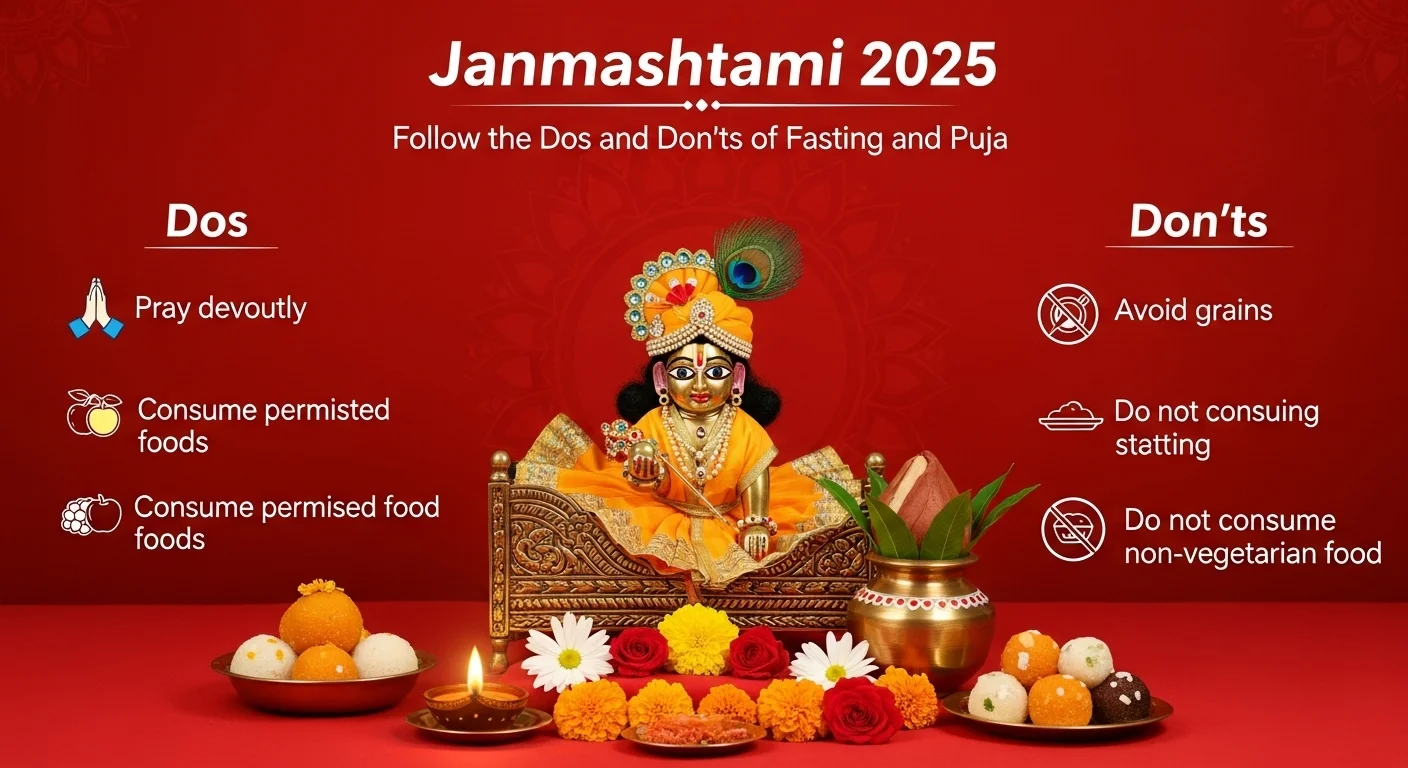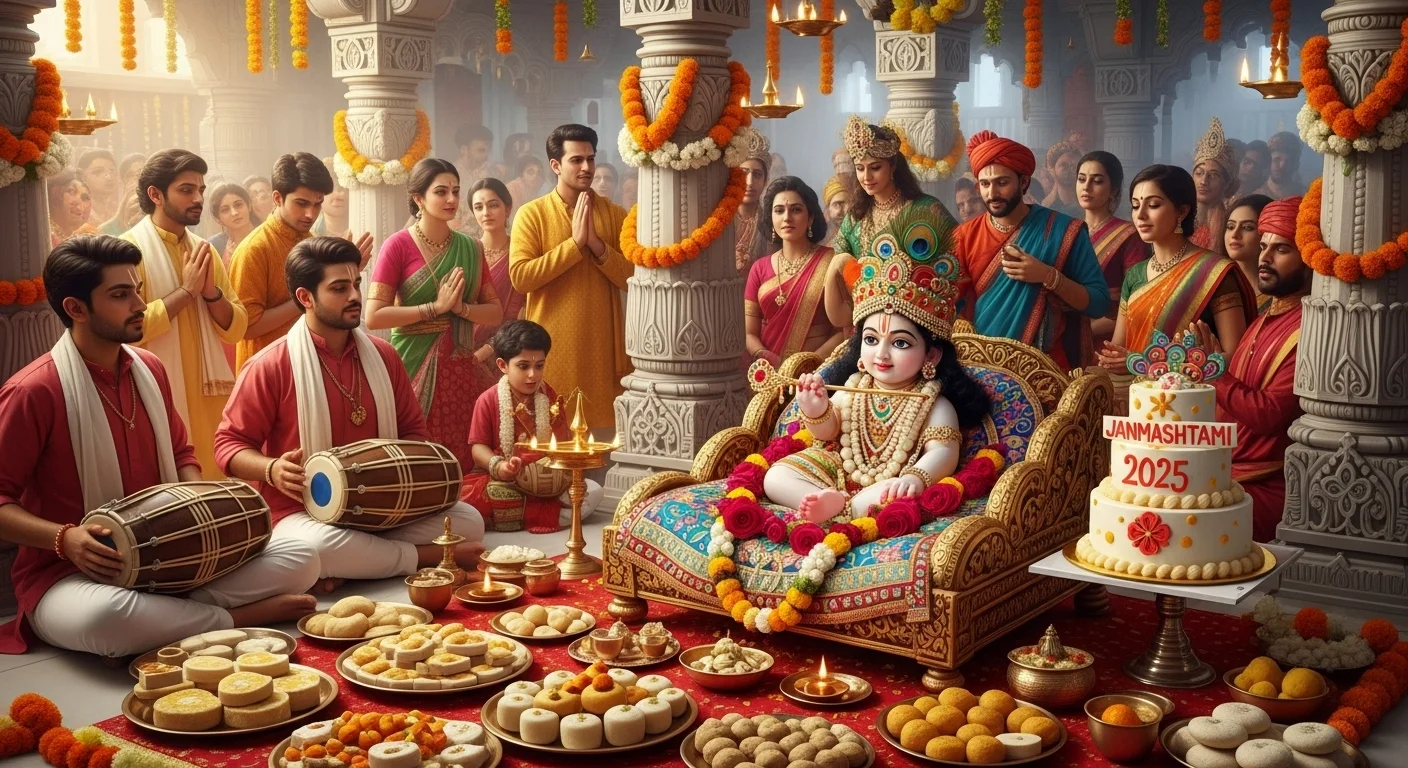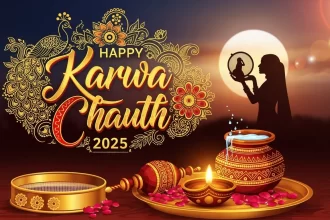You will find thousands of celebrations in temples and homes for Janmashtami 2025. The divine birth of Lord Krishna, as done by Hindus for thousands of years, will be celebrated with enormous devotion, fasting, praying, and activities. It is more than a celebration. It is a complete state of mind and spirit defined by love, faith, devotion and absolute surrender.
Whether you are attending your first or have been celebrating Janmashtami for your whole life, it is important to understand how to fast, puja properly, and consider what you should and shouldn’t do to make it a spiritually rewarding celebration. This full guide will.describe all the dos and don’ts for fasting and puja and ensure your Janmashtami 2025 will be meaningful and traditional.
When will Janmashtami 2025 take place?
In 2025, Krishna Janmashtami will be celebrated on Saturday, August 16. The Nishita Puja Muhurat (actual time of Lord Krishna’s birth; midnight) will be performed between – 11:57 PM and 12:42 AM, on August 17.
Spiritual Significance of Janmashtami
Janmashtami commemorates the birth of Lord Krishna, the eighth avatar of Lord Vishnu, born to Devaki and Vasudeva in a prison cell in Mathura. Krishna is the embodiment of love, wisdom, dharma, and divine joy.
Celebrating this festival is believed to bring prosperity, protection from evil, and liberation from the cycle of birth and death.
Essential Rituals and Customs for Janmashtami 2025
1. Fasting (Vrat)
The fasting on Janmashtami is a sacred practice that has been established as one of the rituals of purification of the body and mind. There are three main types of fasts:
-
Phalahar Vrat: There will be freedom of choice to eat fruits, milk, nuts and vrat-friendly food.
-
Nirjal Vrat: Waterless fasting. This type of fasting is done by people who are devoted to their faith indeed.
-
Satvik Vrat: Allows certain cooked foods that are made from sendha namak and vrat grains.
2. Midnight Puja (Nishita Puja)
The largest and most significant ritual will be performed at midnight, which is Krishna’s birth time. The following will take place:
Abhishekam (holy bath) of Krishna idol with milk, honey, ghee and water. Offering tulsi leaves, butter, and sweets. Singing bhajans and reciting Krishna Janm Katha.
3. Dahi Handi
The next day, energetic Dahi Handi events will occur, invoking the Krishna of Youth and simulating Childhood deeds of Krishna; stealing butter. Youth form human pyramids to break the earthen pot hanging in the air.

Do’s for Janmashtami 2025
1. Observe Proper Fasting Rules
-
Your fast should be determined on your physical ability and spiritual intentions.
-
Your fast is broken only after midnight, after performing puja and aarti.
-
You may take sattvic foods such as fruits, milk, makhana, sabudana, and Vrat flour items.
2. Clean and Prepare Your Puja Room
-
Your home and puja altar need to be cleaned before the festivities.
-
Use fresh flowers, mango leaves, torans, rangoli when decorating your puja area.
-
You can use a small cradle or swing with a Krishna idol or picture.
3. Stay Awake at Night (Jagran)
-
Stay awake at night and chant Krishna-related bhajans and read scriptures like Bhagavad Gita or Bhagavatam.
-
You may invite family and friends to do kirtans and talk about spiritual topics.
4. Perform Puja at a Correct Mauhurat
-
Even though the midnight puja is the best Mauhurat to celebrate at midnight.
-
You can also use items like panjiri, butter, tulsi leaves, mishri and makhan—what Krishna likes.
5. Dress Little Krishna (Bal Gopal) Up
-
Dress Kanha idols in yellow or blue clothes.
-
For decoration you may use bansuri (flute), peacock feathers, and a crown or mukut.
6. Donate and Service
-
You may distribute prasad and donate food and clothing, and/or feed the cows or other animals as a sign of gratitude.
-
Helping others or volunteering on Janmashtami is said to be a positive and powerful form of karma yoga.
Don’ts for Janmashtami 2025
1. Don’t Eat Grains or Salt
-
Strict observers of the fast must avoid regular salt (use Sendha namak instead), rice, wheat, and pulses.
-
Avoid onion, garlic, and processed foods.
2. Don’t Oversleep
-
Devotees are expected to remain awake at least until midnight for Krishna Janm Puja.
-
Sleeping during the puja time is considered disrespectful.
3. Avoid Loud Music or Partying
-
While celebration is encouraged, the mood should remain spiritual and devotional, not chaotic or worldly.
4. Don’t Miss the Midnight Puja
-
Skipping the midnight aarti and Abhishekam means missing the spiritual essence of Janmashtami.
5. Don’t Use Inauspicious Items
-
Avoid black clothing, torn decorations, or old utensils in the puja.
-
Do not offer tulsi leaves that have been plucked the previous day.
6. Don’t Show Disrespect at Dahi Handi
-
Maintain the spiritual and cultural dignity of this fun-filled event.
-
Refrain from drinking alcohol or turning it into a non-religious festivity.
Foods You Can Eat During Janmashtami Fast
Here are some vrat-friendly items that are both delicious and spiritually approved:
-
Sabudana khichdi or vada
-
Kuttu (buckwheat) or Singhara (water chestnut) puris
-
Fruit chaat
-
Makhana kheer
-
Sweet potato curry
-
Lassi, milk, or chaach (buttermilk)
Best Places to Celebrate Janmashtami in India
If you’re looking for immersive experiences, visit these places on Janmashtami:
-
Mathura & Vrindavan: Birthplace and childhood home of Lord Krishna
-
Dwarka, Gujarat: His kingdom after the Mahabharata war
-
ISKCON Temples (Delhi, Bangalore, Mumbai): Known for massive celebrations and cultural programs
-
Gokul & Barsana: Celebrate with Raas Leela performances, jhulan utsav, and more
Also Read: A Guide to the Must-Visit Temples in Mathura and Vrindavan for Janmashtami
Conclusion
Janmashtami 2025 is an opportunity to deepen your connection with Lord Krishna through mindful rituals, heartfelt fasting, and joyful devotion. Understanding and respecting the dos and don’ts ensures that your celebration remains pure, spiritually uplifting, and filled with blessings.
Whether you’re worshiping at home, visiting a temple, or watching a Dahi Handi event, let your heart overflow with love for Sri Krishna—the divine symbol of compassion, wisdom, and eternal joy.







